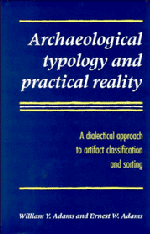 Archaeological Typology and Practical Reality
Archaeological Typology and Practical Reality Published online by Cambridge University Press: 23 November 2009
In the affluent 1960s and 1970s, archaeological procedures were not always closely scrutinized for their practicality or utility. However, this was an exceptional era in archaeology, one that gave researchers the unaccustomed luxury of experimenting with field and laboratory techniques whose practical value was often undetermined. In more normal times, archaeological research is usually carried out under conditions of severe financial and resource constraint. Considerations of practicality and cost-effectiveness can rarely be ignored, and must sometimes be paramount. We (or our funding agencies) are usually obliged to ask: Do our analytical procedures really tell us more than is intuitively obvious? Does increased rigor lead to measurably more useful or meaningful results? Could the same results be obtained by cheaper or less time-consuming means? Can we justify our procedures not only in terms of what we want to know, but why we want to know it? Above all, is our work likely to diminish the unknown, or merely (perhaps for the nth time), to reconfirm what is already known (see WYA 1960: 19)?
In this chapter we will be considering the issue of practical utility with specific reference to archaeological classifications and their use. In theory, two separate issues are involved here: those of practicality and of utility. Practicality refers to whether a procedure is inherently doable (feasible) and/or affordable. Utility refers to whether the results are of any use. Taken together, “practical utility” refers to whether the cost of any procedure, in time and money, is justified by the results.
To save this book to your Kindle, first ensure [email protected] is added to your Approved Personal Document E-mail List under your Personal Document Settings on the Manage Your Content and Devices page of your Amazon account. Then enter the ‘name’ part of your Kindle email address below. Find out more about saving to your Kindle.
Note you can select to save to either the @free.kindle.com or @kindle.com variations. ‘@free.kindle.com’ emails are free but can only be saved to your device when it is connected to wi-fi. ‘@kindle.com’ emails can be delivered even when you are not connected to wi-fi, but note that service fees apply.
Find out more about the Kindle Personal Document Service.
To save content items to your account, please confirm that you agree to abide by our usage policies. If this is the first time you use this feature, you will be asked to authorise Cambridge Core to connect with your account. Find out more about saving content to Dropbox.
To save content items to your account, please confirm that you agree to abide by our usage policies. If this is the first time you use this feature, you will be asked to authorise Cambridge Core to connect with your account. Find out more about saving content to Google Drive.